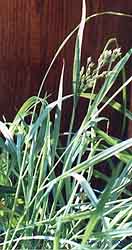

|
|
|
Sweetgrass is a circumboreal plant which is common above 40 degrees north latitude in Asia, Europe, and North America (Walsh 1994). In North America this fragrant grass grows regionally from Labrador to Alaska, and south to New Jersy, Ohio, Illinois, Iowa, South Dakota, Arizona and Washington (Larson 1993). Sweetgrass can be found growing wild in wet meadows, low prairies, the edges of sloughs and marshes, bogs, shaded streambanks, lakeshores, and cool mountain canyons. Sweetgrass rhizomes and roots form a dense mat beneath the soil surface (Walsh 1994).
Sweetgrass flowers from June through August and is easily identified by the sweet vanilla-like fragrance of itís leaves, its 3-flowered spikelets about 1/4 inch long, and its hairy lemmas. The stems of the grass are upright and hollow, growing up to 2 feet tall, without hairs. The leaves are elongated, narrow and flat (up to ľ inch wide, and are also hairless. The Sweetgrass flowers are borne in 3-flowered spikelets, which are arranged in a panicle up to 4 inches long. The spikelets themselves are about 1/4 inch long (the lower 2 flowers are male only, while the upper flower has both stamens and pistils (USDA n.d.).
Sweetgrass usually grows among other grasses or shrubs; it is seldom found in pure stands. Dried Sweetgrass foliage is fragrant because of its coumarin content (Walsh 1994). Sweetgrass is traditionally harvested in late June or early July. Sweetgrass harvested after exposure to frost has little scent. Care should be taken to cut Sweetgrass leaves and not to pull the grass up by its roots so it can grow again the next year. Weeding Sweetgrass areas lessens competition from other plants.
| Sweetgrass Cover Page |
Basketry and Crafts

|